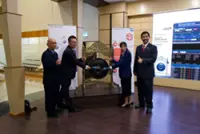Possible errors in the software could then be 'secretly' removed after market launch via update. In this way, safety-related problems could also be fixed without an official recall. — dpa
BERLIN: There’s ever more software in cars these days, and manufacturers are driving us towards the familiar smartphone model of regular updates bringing new features and improvements.
The goal, like on an iPhone or Android phone, is that updates will help existing vehicles to benefit from the latest innovations.
Already a subscriber? Log in
Save 30% OFF The Star Digital Access
Cancel anytime. Ad-free. Unlimited access with perks.





